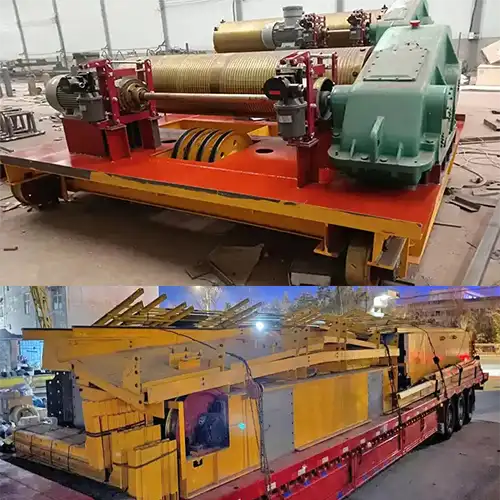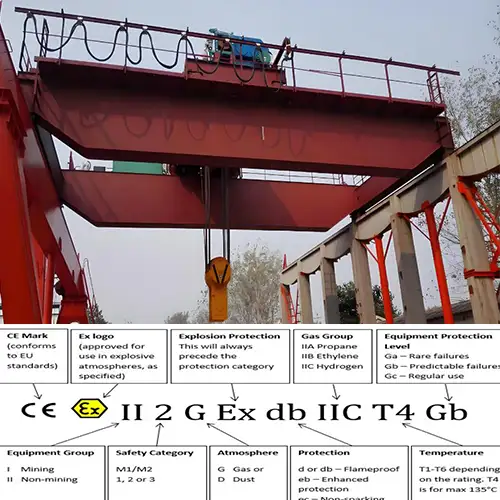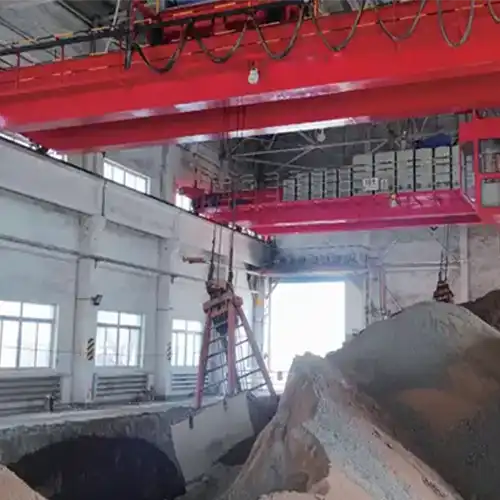
What Makes a Hoist Explosion-Proof? Exd IIBT4 &CT4 ExProof Hoist
Introduction: What Is an Explosion-Proof Hoist?
An explosion-proof hoist is a lifting device designed to prevent sparks, flames, or high heat that could ignite a flammable atmosphere. It's built differently from a standard hoist.In explosive zones, even a small electrical arc, hot surface, or friction can start a fire or explosion. Explosion-proof hoists are specially sealed and tested to stop that from happening. They use flameproof motors, spark-proof components, and enclosed wiring.The key idea is simple: if an internal fault happens—like a spark—it stays inside the hoist and doesn't reach the air around it.
Why They're Critical in Dangerous Workplaces
Some workplaces always have flammable gases, vapors, or dust in the air.
In these areas, safety rules are strict—for a good reason.
Explosion-proof hoists are essential in industries like:
- Oil and gas refineries – where natural gas and vapors are everywhere
- Chemical plants – full of solvents, acids, and flammable liquids
- Paint production and spray booths – where vapor concentration can rise fast
- Mining and coal handling – where dust and methane are common
- Pharmaceutical factories – where fine powders or alcohols are processed
Using regular hoists in these places is unsafe. One small spark or hot surface could cause major damage or even loss of life.So, choosing explosion-proof lifting equipment isn't just a box to check. It's a real safety measure.
If you've ever seen hoists labeled with codes like Exd IIBT4 or CT4, you might have wondered what they mean. They look technical, but they carry important safety information.
This article will help you:
- Understand what Exd IIBT4 and CT4 stand for
- Learn what gases, temperatures, and zones these ratings cover
- Know which hoist components need to meet explosion-proof standards
- Choose the right hoist for your hazardous area based on real needs, not just codes
Whether you're a buyer, engineer, or safety officer, this guide can help you feel more confident when evaluating explosion-proof hoists.
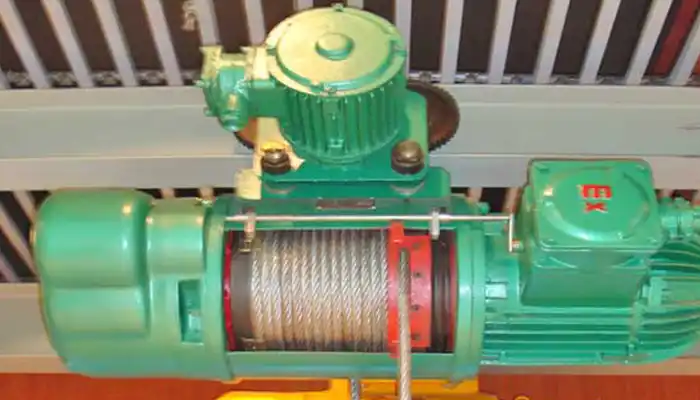
explosion proof hoist for single girder overhead crane
Explosion-Proof Terminology
What Does "Explosion-Proof" Mean in Industrial Use?
In industrial environments, the word "explosion-proof" doesn't mean the equipment can survive an explosion happening around it.
Instead, it means the equipment is designed not to cause an explosion in the first place.
This is a very important difference.
Many machines, especially electrical ones like hoists, can create sparks, arcs, or heat during normal operation.
In areas where flammable gases, vapors, or dust are present, even a small spark can be dangerous.
Explosion-proof equipment is built to make sure that if something goes wrong inside—like a spark or short circuit—it stays inside and does not ignite anything in the air around it.
To meet this goal, explosion-proof hoists are specially designed to:
- Have sealed enclosures to contain internal explosions
- Use materials that won't generate sparks during contact or friction
- Limit the external surface temperature to prevent ignition of surrounding gases
- Follow strict design and testing standards from safety organizations
Explosion-proof equipment is not just for show. It's often legally required in hazardous work areas.
Key Explosion-Proof Standards You Should Know
Explosion-proof hoists and other equipment must meet specific national or international standards.
These standards are written by technical safety organizations and are enforced by local laws or workplace safety rules.
Here are the three most common standards in the industry:
ATEX (European Union)
- ATEX stands for "Atmosphères Explosibles" and is the explosion protection standard in the EU.
- It applies to all equipment used in potentially explosive environments.
- ATEX classifies areas into Zone 0, Zone 1, and Zone 2 based on how often an explosive atmosphere is present.
- It also defines safety categories for equipment used in each zone.
IECEx (International)
- IECEx is a global standard issued by the International Electrotechnical Commission (IEC).
- It's used in many countries outside Europe, such as Australia, South Africa, and Gulf nations.
- IECEx standards are very similar to ATEX but used for global certification and easier equipment trading between countries.
GB3836 (China)
- GB3836 is the Chinese national standard for explosion-proof electrical equipment.
- It is based on IEC standards but has additional technical requirements specific to China.
- GB ratings such as CT4 come from this system and are commonly seen in Chinese-made explosion-proof hoists.
All three standards serve the same purpose: making sure the equipment is safe to use in flammable or explosive environments. However, the markings and terms may vary slightly from one system to another.
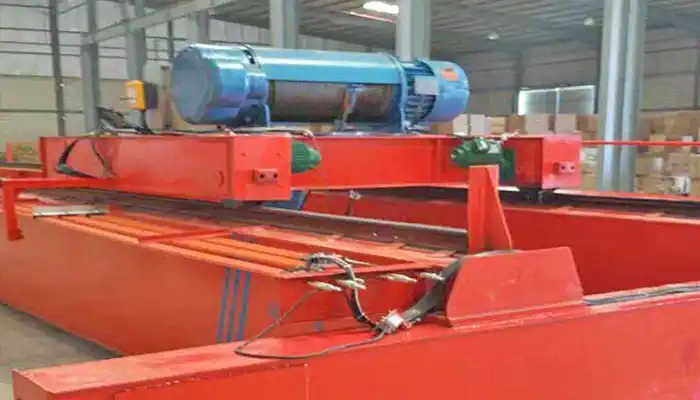
double girder explosion proof hoist crane
What's the Difference Between Explosion-Proof, Flameproof, and Intrinsically Safe?
These three terms are often used when talking about equipment safety in hazardous locations.
Although they are related, they describe different protection methods.
Understanding them helps you know what kind of protection your hoist really has.
Explosion-Proof
- Explosion-proof usually refers to equipment that is designed to keep internal sparks or flames from escaping.
- These products are built with strong, sealed enclosures that can contain an explosion if one occurs inside.
- For example, a motor labeled "Ex d" means it has a flameproof housing that can contain internal ignition.
- This is the most common protection method used in explosion-proof hoists.
Flameproof
- Flameproof is closely related to explosion-proof.
- In fact, in many systems like IECEx and ATEX, flameproof is a type of explosion-proof protection.
- A flameproof device is one that can allow an explosion to occur inside, but it prevents the flame from escaping through any joints or openings.
- It's tested to make sure hot gases are cooled before they reach the outside air.
Intrinsically Safe
- Intrinsically safe equipment works on a totally different principle.
- Instead of trying to contain an explosion, it prevents one from happening by limiting the energy inside the device.
- These devices are designed so that even in case of damage or failure, they can't produce enough heat or spark to ignite anything.
- Intrinsic safety is often used in small, low-energy devices like sensors, measuring tools, or handheld controls—not in heavy machinery like hoists.
If you're in charge of selecting lifting equipment for a hazardous zone, it's important to understand what type of protection you really need.
Don't just look at the word "explosion-proof." Check which standard it follows and what safety method it uses.Explosion-proof hoists usually rely on flameproof (Ex d) protection, combined with careful design of the electrical and mechanical systems.
Control parts, such as pendants or limit switches, may also follow intrinsically safe or sealed designs, depending on the application.Knowing these differences helps you make better decisions and ask the right questions when dealing with hoist suppliers or safety inspectors.
The Key Ratings: What Do Exd IIBT4 and CT4 Mean?
Explosion-proof hoists must meet specific safety ratings. Two common ones are Exd IIBT4 (international) and CT4 (Chinese GB standard). Here's what they really mean:
What Is Exd IIBT4?
Used in ATEX and IECEx systems, this rating breaks down as:
- Ex – For explosive atmospheres (gases, vapors, dust).
- d – Flameproof enclosure. Contains any internal explosion.
- IIB – Gas group. Suitable for gases like ethylene (medium risk). Higher than IIA, lower than IIC.
- T4 – Temperature class. Max surface temp ≤ 135°C. Prevents hot surfaces from igniting gases.
An Exd IIBT4 hoist is safe for zones with ethylene and similar gases. Common in oil, chemical, and paint industries. It prevents internal sparks from spreading and ensures external parts don't overheat.
What Is CT4?
Based on China's GB3836 standard, CT4 is simpler but stricter in gas classification:
- C – Equivalent to IIC gas group (hydrogen, acetylene — higher risk than IIB).
- T4 – Same as above: max surface temp ≤ 135°C.
CT4 vs. IIBT4 Comparison:
| Item | Exd IIBT4 | CT4 (GB Standard) |
|---|---|---|
| Gas Group | IIB (medium hazard) | IIC-equivalent (high) |
| Temp Class | T4 ≤ 135°C | T4 ≤ 135°C |
| Safety Level | Medium | Higher |
| Common Use | Ethylene zones | Hydrogen-rich zones |
CT4-rated hoists are built for more hazardous environments than IIBT4. Use CT4 when gas types are unknown or potentially severe.
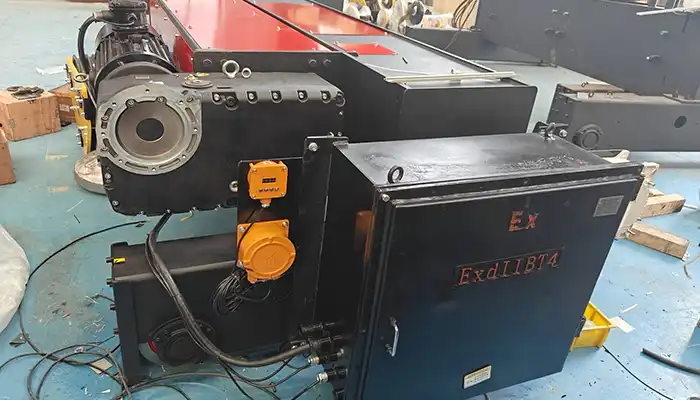
Euroepan style wire rope explosion proof hoist
Core Components That Must Be Explosion-Proof
To truly call a hoist "explosion-proof," it's not just about having a special label or certificate.
Every critical part must be built to stop sparks, heat, or flame from escaping into a hazardous atmosphere.
Let's break down the key components you should always check when evaluating an explosion-proof hoist.
Motor
The motor is the heart of the hoist—and one of the biggest spark sources.
- Explosion-proof motors are enclosed in a flameproof casing (Ex d type).
- The casing is strong enough to contain an explosion if a fault or spark occurs inside.
- Openings like the shaft or cooling vents are sealed or protected to prevent hot gases from escaping.
- Cooling is often indirect or through ribbed enclosures rather than open fans.
Why it matters: A normal industrial motor can create arcs during start-up or load changes. In a hazardous area, that's a risk. A sealed motor prevents this danger.
Electrical Control Box
This is where your hoist's brain lives—relays, circuit boards, and wiring.
- It should have a flameproof (Ex d) or intrinsically safe (Ex i) design.
- Flameproof boxes are fully enclosed in thick metal casings.
- Intrinsically safe boxes use low voltage and current, so sparks cannot ignite gas, even during faults.
- Gaskets and joints must be tested to prevent gas entry.
Key Tip: Some buyers skip this part and only focus on the motor. But if your control box isn't protected, it's a weak point in the whole system.
Pendant Control
This is the handheld control device that the operator uses.
- It must be sealed, with a tightly enclosed body to prevent sparks from escaping.
- Buttons are made from non-sparking plastic or rubber.
- Internal wires are covered and isolated.
Note: Pendant control units are often overlooked, but they're exposed to daily handling and impact. A spark from worn buttons could be dangerous in gas zones.
Limit Switches and Sensors
These devices stop the hoist from overtravel or detect position and load.
- Must be built with spark-resistant components.
- Housings are sealed or rated flameproof, just like control boxes.
- Internal parts like contacts and springs must be low energy or isolated.
What to ask: Request documentation on whether limit switches are zone-rated. Not all hoists have explosion-proof switches by default.
Brakes
Brakes create friction—and friction can create heat or sparks.
- Explosion-proof hoists use enclosed electromagnetic brakes or non-sparking friction materials.
- Brakes are often placed inside the motor enclosure or in sealed compartments.
Buyer tip: Ensure the brake system is integrated with the explosion-proof motor or housed separately in a certified enclosure.
Wiring and Connectors
Wires are more than just cables—they can carry risk if not properly handled.
- Cables should be armored, with strong insulation layers.
- All cable entries into the motor or control box should use explosion-proof glands (Ex d certified).
- Connectors must be sealed to prevent gas seepage or moisture entry.
Best practice: Use gas-tight conduit systems or metal-clad cables for areas where gas exposure is possible.
Even if a hoist looks like it's explosion-proof on the outside, the real test is inside the components. Ask for a full component list and make sure each part—motor, controls, brakes, wiring—is built for explosive environments. You're not just buying a hoist—you're buying peace of mind in a dangerous workplace.
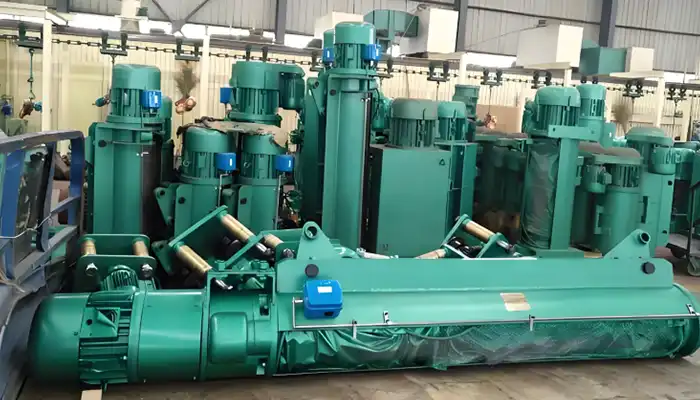
large lifting explosion proof wire rope electric hoist
How Explosion-Proof Design Prevents Ignition
The term "explosion-proof" doesn't mean the equipment won't explode—it means if something goes wrong inside the equipment, it won't ignite the surrounding atmosphere. That's the key.
Containment: If Something Sparks Inside, It Stays Inside
In an explosion-proof hoist, especially one rated "Ex d", the core parts like the motor and control box are inside flameproof enclosures.
- These enclosures are thick-walled and built to withstand internal explosions.
- If gas enters the motor housing and ignites due to a spark or fault, the explosion is contained.
- The design prevents flame, pressure, or hot gases from escaping into the surrounding air.
Why this matters: In hazardous zones, even a small flame escaping through a loose opening can cause a large-scale explosion. Containment ensures the danger doesn't spread.
Heat Control: Keeping Surface Temperatures Below Ignition Point
Another danger is a hoist surface getting too hot—hot enough to ignite nearby gas or vapor.
- Explosion-proof designs ensure the external temperature never exceeds the rated "T-class."
- For example, a T4-rated hoist must never go above 135°C, even under full load.
- Cooling is done using passive methods—like finned housings, enclosed airflow channels, or oversized components to reduce friction and heat buildup.
In many gas environments, the ignition temperature is low. For instance, ethylene ignites at around 425°C, but safety standards require a big margin. That's why T4 (135°C) is so widely used.
Spark Suppression: No Arc or Spark Can Escape
Sparks can come from many places: electrical relays, motor brushes, switches, or even worn-out wiring. In explosion-proof hoists:
- Electrical contacts are placed inside sealed or flameproof housings.
- Moving parts that could strike and spark (like metal-on-metal brakes or contactors) are shielded or made from non-sparking materials.
- All connectors and wiring paths use sealed cable glands, and in some cases, flame arrestors.
Even a brief arc inside an unprotected control panel could be deadly in Zone 1 or Zone 2. That's why real explosion-proof design focuses so much on isolating all potential spark points.
Putting It All Together
Here's how it works in action:
- If gas leaks into the hoist's motor box and ignites—a flame stays trapped inside.
- The enclosure absorbs the pressure without bursting.
- The surface stays cool enough that nearby gas can't ignite.
- And no spark escapes through buttons, wiring, or connectors.
This is how a properly certified explosion-proof hoist protects people, property, and production—even when faults or accidents happen.
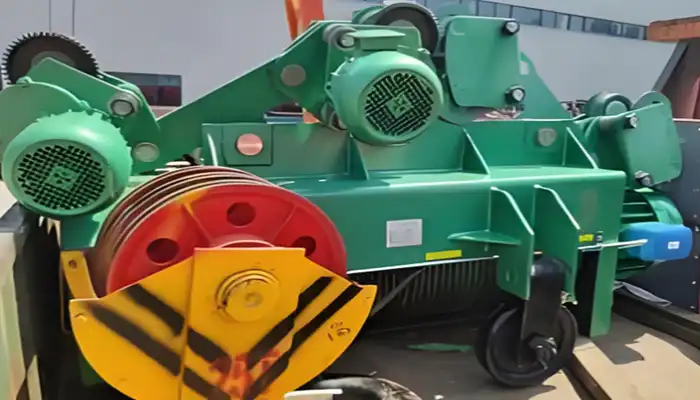
large capacity explosion proof electric hoist
Application : Where Each Rating Is Used
Knowing the technical ratings like Exd IIBT4 and CT4 is important—but it's equally useful to understand where these hoists are actually used on the ground. Different hazardous environments demand different safety levels.
Where Exd IIBT4 Hoists Are Commonly Used
The Exd IIBT4 rating fits well in environments with moderate gas hazards. These areas usually have gases that are less aggressive or explosive compared to the highest-risk zones. Some examples:
- Petrochemical workshops:
These workshops handle hydrocarbon gases such as ethylene or propane. Exd IIBT4 hoists provide reliable safety while allowing smooth handling of heavy parts and machinery in these controlled environments. - Gas stations and fueling areas:
Gasoline vapors fall under gas groups suitable for IIB. Hoists used here must prevent sparks during maintenance or refilling operations, making Exd IIBT4 a good fit. - Paint shops and solvent handling:
Many organic solvents emit vapors matching the IIB group. Paint shops often require hoists to lift and move heavy containers safely without ignition risk.
Exd IIBT4 hoists are the go-to for medium-risk environments, where gases like ethylene, propane, or solvent vapors are common but not the most volatile. They balance safety and cost-effectiveness well.
Where CT4 Hoists Are Best Suited
The CT4 rating is designed for higher-risk environments. These are places where gases can be far more explosive or have a lower ignition energy, requiring a stricter safety margin.
- Refineries and cracking units:
These sites often deal with hydrogen, acetylene, or other highly flammable gases classified under the IIC gas group. CT4 hoists are essential here to prevent accidents during heavy lifting in harsh conditions. - Solvent recovery and chemical plants:
Recovery units handle concentrated vapors and mixtures of gases with very low ignition points. CT4-rated hoists ensure reliable operation without risk of sparks or hot surfaces. - Hydrogen plants and storage areas:
Hydrogen is one of the most explosive gases. CT4 hoists with their stricter standards protect workers and assets by meeting these high safety requirements.
CT4 hoists are designed for the most hazardous zones where explosive gas risks are extreme, and where any ignition could have severe consequences.
Choosing the Right Rating for Your Site
- If your site atmosphere contains gases like ethylene, propane, or solvent vapors, and the risk is controlled, Exd IIBT4 hoists typically suffice.
- If you deal with highly flammable gases such as hydrogen or acetylene, or if your process is critical and risk tolerance is minimal, CT4 hoists are necessary.
Always consult your safety officer or a certified professional to verify your specific zone classification and the appropriate hoist rating.
Selecting the Right Explosion-Proof Hoist
Choosing the right explosion-proof hoist is critical. It's not just about buying a certified product but ensuring it fits perfectly with your specific hazardous environment and operational needs.Here's how to make the right selection step-by-step.
Identify the Zone Classification
The first step is to know your site's hazard zone. Zones are defined based on how often and how long explosive atmospheres are present:
- Zone 0: Explosive atmosphere is present continuously or for long periods.
- Zone 1: Explosive atmosphere is likely to occur during normal operation.
- Zone 2: Explosive atmosphere is not likely to occur, and if it does, it will exist for a short time.
Different zones require different equipment protection levels. For example, a Zone 1 area needs stricter safety than Zone 2. Make sure you have clear documentation of your zone classification from a safety audit or risk assessment.
Determine Gas Group and Temperature Class
Next, find out the gas group and temperature class for your facility's atmosphere:
- Gas Group: Identifies the type of gas present (IIB, IIC, etc.).
IIB gases are less explosive than IIC gases. Choosing a hoist rated for the wrong gas group can cause a dangerous mismatch. - Temperature Class: Maximum surface temperature the hoist can safely reach without igniting gas (e.g., T4 = max 135°C).
Get a copy of the gas analysis report or consult your process engineers. Use this to match the hoist's rating (like Exd IIBT4 or CT4) with your actual environment.
Evaluate Mechanical vs. Electrical Component Requirements
Explosion-proof hoists are made up of many parts. Some components have stricter requirements than others:
- Mechanical parts: Such as hooks, brakes, and limit switches must be designed to prevent sparks or overheating.
- Electrical components: Motors, control boxes, wiring, and connectors need special enclosures or intrinsic safety features.
What to check: Ask your supplier for detailed specs on each component's protection type. Sometimes, a hoist might have an explosion-proof motor but standard controls—not enough for your site.
Compliance with Local or Industry-Specific Regulations
Regulations vary by country and industry. Always confirm:
- If your hoist meets local safety standards (such as ATEX in Europe, IECEx internationally, or GB standards in China).
- If your industry (oil & gas, chemical, mining) has extra certification or testing requirements.
- That all documentation and certificates are valid and up to date.
Bonus tip: Some regulations require periodic inspection and re-certification of explosion-proof equipment. Ask about service and maintenance support before purchase.
Summary: Your Checklist for Choosing the Right Hoist
- Confirm your site's hazard zone.
- Match the hoist's gas group and temperature class to your facility's conditions.
- Verify all critical components are explosion-proof, not just the motor.
- Ensure full compliance with your local and industry regulations.
- Consider future maintenance, inspection, and certification needs.
Making the right choice protects your workers and assets and keeps your operations running safely and smoothly. When in doubt, always seek advice from qualified safety experts or your crane supplier.
Conclusion
To wrap up, understanding the explosion-proof ratings like Exd IIBT4 and CT4 is essential when choosing hoists for hazardous environments.
What These Ratings Really Mean
- Exd IIBT4 indicates a hoist built with a flameproof enclosure ("d"), designed for gases in the IIB group (like ethylene), and a maximum surface temperature of 135°C (T4). This rating is suited for many moderately hazardous areas.
- CT4—a Chinese standard—corresponds roughly to a more stringent group, similar to IIC, handling more dangerous gases like hydrogen, with the same temperature class. It's meant for high-risk, highly explosive environments.
Knowing these ratings helps you select the right hoist to match the specific gases and temperature conditions at your facility.
Safety and Compliance Are Non-Negotiable
Explosion-proof hoists are not just about meeting legal requirements—they're about protecting lives, equipment, and your entire operation.
- Using the wrong rating or uncertified equipment puts your site at serious risk.
- Properly certified hoists minimize fire or explosion hazards, especially in places like refineries, chemical plants, or paint shops.
A Final Word of Advice
Before you buy or install an explosion-proof hoist:
- Always check the certification documents carefully. Look for valid certificates from recognized bodies like ATEX, IECEx, or local authorities.
- Confirm the hoist's gas group and temperature rating fit your specific hazardous zone.
- Don't hesitate to consult safety experts or crane manufacturers who specialize in explosion-proof equipment.
This careful approach ensures your hoist won't just lift loads safely, but also keep your entire facility safe from fire and explosion risks.Taking these steps seriously helps you make smart, confident decisions. And that's how you get the right explosion-proof hoist—built to last, built to protect.
